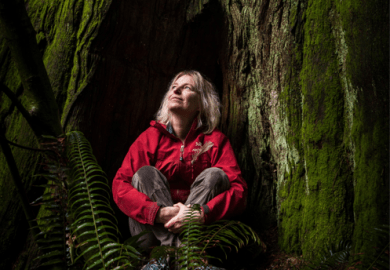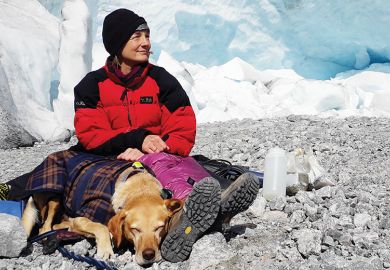This year marks the centenary of a great earthquake. With a magnitude of 8.8, it ripped along 500km of faultline and caused great destruction, killing between 1,000 and 2,000 people. The violent displacement of the ocean floor caused a tsunami that swept across the Pacific. And it was nothing to do with San Francisco whatever.
Whether the inhabitants of Ecuador are marking the 100th anniversary of the great earthquake of January 31, 1906, or not, I don't know. What is certain is that there are a number of celebrations planned to mark the centenary of a much smaller earthquake, that of April 18, 1906, in California. The Seismological Society of America is hosting a major anniversary conference and, of course, there are books. There were books in 1906, too. The San Francisco earthquake was big news, and numerous authors attempted to cash in by rushing out potboilers full of lurid accounts of the disaster. I have one of these and it pads out the volume with an endless series of plates from what appears to be the 1906 version of Homes and Interiors magazine, with stock photos of comfy rooms bearing captions such as "Luxury before the earthquake struck".
I doubt that one could get away with that today. Two new studies that have been published to coincide with the San Francisco anniversary set their sights much higher. These are The Great Earthquake and Firestorms of 1906 by Philip Fradkin, and A Crack in the Edge of the World by Simon Winchester. Very different from each other, they make an interesting comparison.
Considering that they both take the same subject, it might be surprising that they could be quite so unalike, but they are written from completely different perspectives. Fradkin writes from the point of view of the local historian. Meticulously researched in local archives, his book's aim is to tell the story of what happened from the viewpoint of the people who lived through it.
Winchester, on the other hand, is a former geologist whose first interest is explaining the geological background to earthquakes in general, and the 1906 event in particular, back to first causes (and I mean first causes - it is a bit like starting a biography with an account of the subject's descent from primordial protoplasmic slime). A Crack in the Edge of the World is a frustrating book. Reading it, one alternates between admiration and a desire to hurl the book against the nearest wall: admiration because anyone who attempts a layman's explanation of obduction deserves praise (obduction - Winchester does not actually use the word - is the process by which bits of oceanic crust get scraped off on top of continents); fury because of the way the book reads as a series of footnotes to parentheses between diversions from digressions.
Considering that the subject of the book is the San Francisco earthquake, one might expect the author to have reached this by page 116, where one reads, for instance, that the first director of the US Geological Survey adopted the name of James Todd in order to marry a black nursemaid; but it is another 100 pages before the earthquake actually occurs. He also indulges too much in hyperbole, with a tendency to overuse words such as "terrifyingly". Am I terrified by the heat of the earth's mantle? Not really. And I do not find the accuracy of modern seismometers "unimaginable". I can imagine it pretty well, though it helps that I work with them.
The book is padded out with a lot of would-be travel writing that will not have Bill Bryson shaking in his shoes. Did we really need to know that Winchester got a speeding ticket in British Columbia? What is more serious is the sheer number of mistakes, both large and small. A few examples: Winchester seems to think that adulteration of food was a novelty in 1906 - any social historian could have corrected him on that. He associates the discovery of plate tectonics with the space age, which had nothing to do with it (the Cold War was what provided the opportunity). He asserts that knowledge of the structure of the Earth's interior is a recent discovery, when it dates back to the beginning of the 20th century. And so on. His technical appendix on seismology is very nicely written and very understandable - but at the same time shot through with numerous errors.
Fradkin, on the other hand, knows his limitations. He is clearly ill at ease with the science of earthquakes and avoids the subject as much as possible. His forte is human history. The reason why the San Francisco earthquake is so important scientifically is because it was the inspiration for H. F. Reid's work on elastic rebound theory, which has underpinned all work on earthquake dynamics ever since. You would not think this from reading Fradkin, whose only interest in elastic rebound is that Reid was late in delivering his manuscript to Andrew Lawson, the compiler of the official report on the 1906 earthquake.
But his account of what happened above ground is first-rate. As well as presenting a fine narrative of events as they unfolded, Fradkin also expounds a number of important themes: it is well known how knowledge of previous earthquakes in California was deliberately suppressed lest it discourage immigration and investment, but Fradkin also documents how attempts were made to cover up the 1906 quake itself by blaming all the damage on the fire.
Fradkin draws a faint parallel between the events of April 18, 1906, and September 11, 2001, but a much better parallel would have been on offer, had he written a little later, with the aftermath of Hurricane Katrina.
Both disasters were handled poorly, and both had a strong ethnic dimension.
In both, there was a need to distinguish between rescuing supplies from doomed stores and looting. Much depended on the colour or social status of the individual concerned.
Winchester believes that the handling of disaster (principally the following fire) was efficient, and that Brigadier General Frederick Funston was the hero of the day. So Funston himself made out - but Fradkin paints a different story, and he has the facts to back his version up. Both Funston and Mayor Eugene Schmitz come over as men confronted with events that were beyond their ability to deal with effectively. Both subsequently had to justify their actions as best they could and conceal what was incompetent, counterproductive or even illegal.
In fact, a large amount of the destruction was directly caused by botched attempts to control the fire. Badly executed attempts to dynamite firebreaks either expedited the spread of the fire or created entirely new fires. Fradkin's book has the subtitle "How San Francisco nearly destroyed itself" - and he makes his case. Particularly disastrous was the dynamiting of the Viavi building on April 20 without regard to the thousands of gallons of spirit alcohol stored there; the resulting fire from this act alone consumed 50 city blocks, something entirely missed by Winchester.
Fradkin's book has a few problems besides its weakness at a scientific level. In particular, the narrative runs into the sand towards the end; the author gets bogged down in an overly detailed account of the corruption trial of "Boss" Abraham Ruef (whom he compares to Dreyfus) at the end of 1906. This is of marginal relevance, and the book lacks the concluding peroration it deserves. However, for anyone wanting to learn what happened to San Francisco in the terrible days following the earthquake of April 18, 1906, Fradkin's book can be recommended.
Thanks to its time and place, probably no major earthquake prior to the 1906 San Francisco one is so well documented, both in words and images. Mark Klett has drawn on the photographic archive of the earthquake to compile After the Ruins , a volume resulting from an exhibition of archival photos of the damage paired with modern photos showing what the same spots look like today.
This exercise in "rephotography", as Klett calls it, is always fascinating. I have some experience of it, having spent a pleasant weekend in 1987 driving round the Essex countryside attempting to update archival photos of damage from the 1884 Colchester earthquake with images of the extant buildings 103 years later. The end product is not just interesting intellectually, but also useful in understanding the quality of the historical building stock, from which one can draw deductions about how earthquake resistant it was. Klett's book will be of value on many levels: it is presented as a work of art, which it is, but will appeal to artists, photographers, historians, seismologists and engineers alike.
Meanwhile, what of the next San Francisco earthquake? Seismologists estimate a 21 per cent chance of an earthquake greater than 6.7 magnitude occurring on the San Francisco section of the San Andreas Fault before 2032, and 62 per cent for the Bay area in general. That will be the real test of how much has been learnt about the handling of earthquake disasters in California.
Roger Musson is head of seismic hazard, British Geological Survey, Edinburgh.
The Great Earthquake and Firestorms of 1906: How San Francisco Nearly Destroyed Itself
Author - Philip L. Fradkin
Publisher - University of California Press
Pages - 418
Price - £17.95
ISBN - 0 520 23060 4
Register to continue
Why register?
- Registration is free and only takes a moment
- Once registered, you can read 3 articles a month
- Sign up for our newsletter
Subscribe
Or subscribe for unlimited access to:
- Unlimited access to news, views, insights & reviews
- Digital editions
- Digital access to THE’s university and college rankings analysis
Already registered or a current subscriber?



